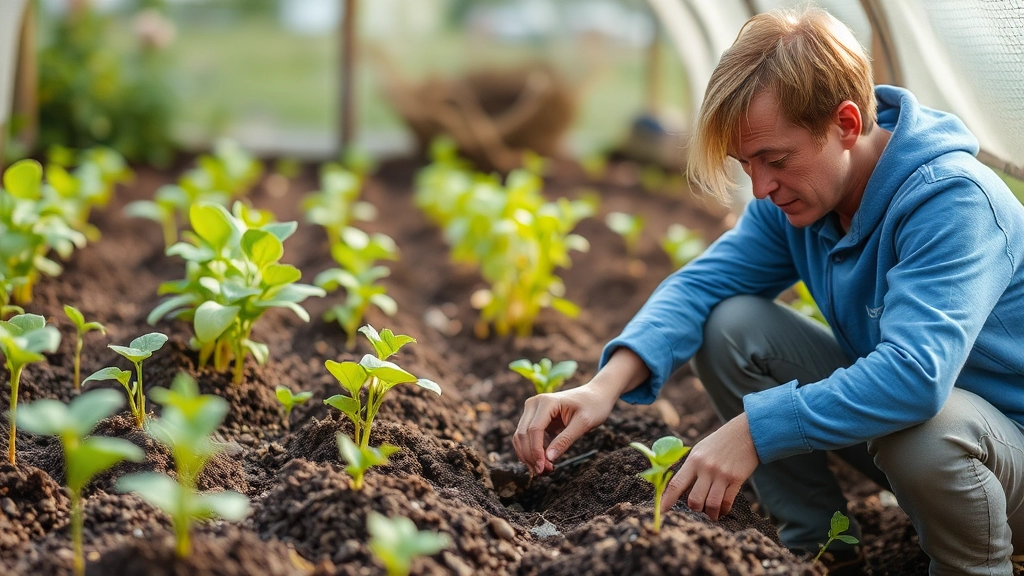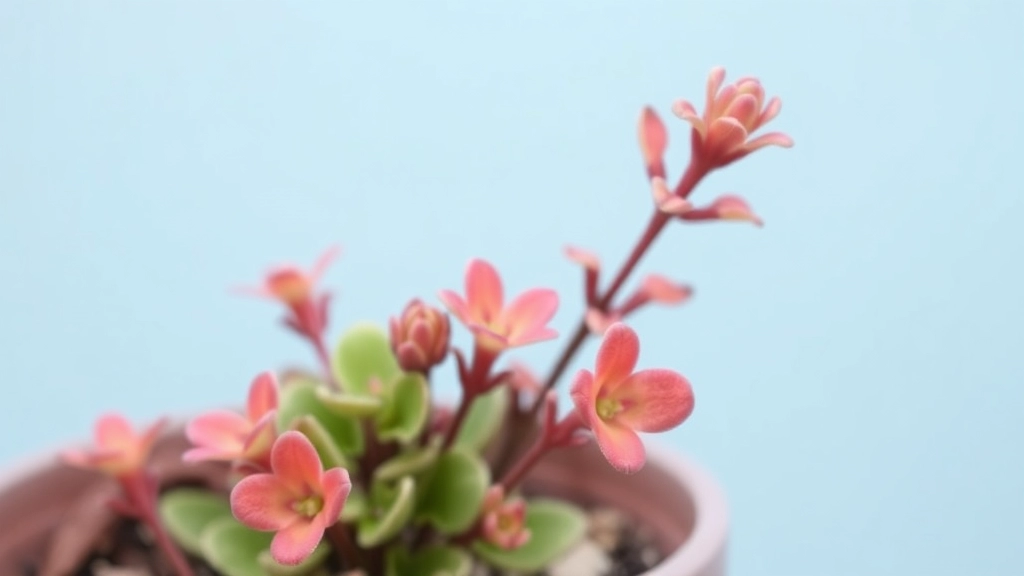Introduction to Kalanchoe suarezensis
As an avid succulent enthusiast, I’m thrilled to introduce you to the fascinating world of Kalanchoe suarezensis. This unique plant, native to Madagascar, is a true gem among succulents. With its striking bluish-green leaves and remarkable adaptability, it’s no wonder that Kalanchoe suarezensis has captured the hearts of plant lovers worldwide.
What to Expect in This Article
In this article, we’ll explore everything from its natural habitat and physical characteristics to essential care tips and propagation methods. Whether you’re a seasoned gardener or a curious beginner, you’ll discover why this resilient succulent is a must-have for any collection. So, let’s dive in and uncover the secrets of successfully growing and nurturing Kalanchoe suarezensis!
Overview of Kalanchoe suarezensis
Let’s dive into the world of Kalanchoe suarezensis, shall we?
This little gem’s got a story to tell.
Native to Madagascar, it’s a succulent that’s turning heads in the plant community.
Why? It’s tough as nails and looks pretty darn cool.
Think of it as the rebel of the plant world – thriving where others can’t.
But here’s the kicker: it’s not just about looks.
This plant’s got some tricks up its sleeve.
From medicinal properties to air purification, it’s a multi-tasker.
Now, you might be wondering, “Why should I care?”
Well, if you’re into low-maintenance plants that pack a punch, this is your guy.
It’s perfect for busy folks or those who don’t have a green thumb.
Plus, it’s a conversation starter. Trust me, your mates will be asking about it.
So, whether you’re a plant newbie or a seasoned pro, Kalanchoe suarezensis is worth checking out.
Stick around, and I’ll spill all the secrets on how to keep this bad boy thriving.
Habitat and Distribution

Alright, let’s dive into where this funky little plant, Kalanchoe suarezensis, calls home. Trust me, it’s not hanging out in your average backyard!
Where’s it from?
This succulent’s a real homebody, sticking to its roots in Madagascar. Yep, that’s right – it’s endemic to this island off the coast of Africa. But don’t go thinking you’ll spot it everywhere on your Madagascan holiday.
Specific spots
K. suarezensis is pretty picky about where it sets up shop. You’ll find it mostly in the northern part of the island, particularly in the Antsiranana region. It’s like it’s got a favourite neighbourhood and won’t budge!
What’s the vibe?
Now, let’s talk about the kind of place this plant digs:
- Rocky areas: It loves to cling to limestone cliffs and outcrops
- Dry forests: You’ll spot it in the understory of deciduous woodlands
- Coastal zones: It’s not afraid of a bit of sea breeze
Climate-wise, we’re talking hot and dry. This plant’s not a fan of cold, wet feet. It’s adapted to survive in areas that get sporadic rainfall, so it’s tough as nails when it comes to drought.
Why’s this important?
Understanding where K. suarezensis naturally grows helps us mimic those conditions when we’re trying to grow it ourselves. It’s like giving it a little slice of home, even if it’s in a pot on your windowsill halfway across the world.
Conservation chat
Here’s the thing – because it’s only found in this small area, K. suarezensis is vulnerable to habitat loss. As Madagascar’s forests face threats from deforestation and climate change, so does our spiky friend.
So, next time you’re admiring your Kalanchoe suarezensis, remember you’re looking at a little piece of Madagascar right there in your living room. Pretty cool, right? If you’re interested in other unique Kalanchoe species, you might want to check out the Kalanchoe humilis, which has its own fascinating characteristics. And for those who prefer more common varieties, the Kalanchoe blossfeldiana is a popular choice for indoor gardening.
Physical Characteristics
Alright, let’s dive into the physical characteristics of Kalanchoe suarezensis.
This succulent’s a real head-turner, no joke.
Picture this: thick, fleshy leaves that look like they’ve been carved from jade.
They’re not your average green, though. These babies sport a bluish-green hue that’s pretty unique.
The leaves? They’re arranged in a rosette pattern, kinda like a flower opening up.
But here’s the kicker – each leaf has these cool serrated edges. Looks like nature’s own saw blade.
Size and Shape
Now, let’s talk size.
Kalanchoe suarezensis isn’t exactly a giant. It usually grows to about 30-40 cm tall.
But what it lacks in height, it makes up for in spread. These plants can get pretty bushy.
Flowers
When it’s flowering time, things get even more interesting.
You’ll see clusters of small, star-shaped flowers popping up.
These blooms? They’re usually yellow or orange. Real eye-catchers.
Stems and Texture
The stems are thick and sturdy, perfect for supporting those meaty leaves.
And get this – the whole plant has this waxy coating. It’s like nature’s own sunscreen.
So, what’s the takeaway?
Kalanchoe suarezensis is a compact, eye-catching succulent with unique features that make it stand out from the crowd.
Growing Conditions

Alright, let’s chat about how to keep your Kalanchoe suarezensis happy and thriving. Trust me, once you nail these growing conditions, you’ll be well on your way to becoming a succulent superstar.
Sunlight: The Goldilocks Zone
First things first, these little beauties are sun-lovers, but they’re not trying to get a sunburn. Here’s the deal:
- Aim for bright, indirect light
- A few hours of morning sun? Perfect
- Afternoon sun? Too harsh, mate – think sunscreen for plants
I learned this the hard way when I plopped my first Kalanchoe suarezensis on a south-facing windowsill. Let’s just say it wasn’t pretty. Now, I’ve got mine chilling near an east-facing window, and it’s living its best life.
Soil: The Drainage Game
Next up, let’s talk dirt. Or rather, let’s talk about how to avoid dirt that’s too… well, dirty.
- Go for a well-draining succulent mix
- Or DIY it: regular potting soil + perlite or coarse sand
- Bottom line: roots hate sitting in water
Think about it like this: would you want to stand in a puddle all day? Neither does your Kalanchoe suarezensis.
Temperature: Keeping It Comfy
These guys aren’t too fussy about temperature, but they do have their limits:
- Sweet spot: 15-24°C (60-75°F)
- Can handle a bit cooler, but not below 10°C (50°F)
- Hot? They’ll manage, but give ’em some shade
I once left mine out during a heatwave. It survived, but looked about as happy as I do in a sauna – not a pretty sight.
Watering: Less Is More
Here’s where most people mess up. These succulents are like camels – they store water for the dry times.
- Let the soil dry out completely between waterings
- In winter? Even less water
- Overwatering = root rot = sad plant (and sad you)
Pro tip: Stick your finger in the soil. If it’s dry up to your first knuckle, it’s watering time. If not, leave it be.
Humidity: Not a Big Deal
Good news for those of us who can’t be bothered with humidifiers:
- Kalanchoe suarezensis doesn’t need high humidity
- Normal room humidity is fine
- Just avoid super dry air (like near heaters)
Fertilizer: The Cherry on Top
Think of fertilizer as a treat, not a necessity:
- Use a balanced, water-soluble fertilizer
- Feed during growing season (spring and summer)
- Dilute to half strength – these guys are light eaters
Remember, overfeeding is like force-feeding your plant junk food. Not cool.
So there you have it – the inside scoop on growing conditions for Kalanchoe suarezensis. Nail these, and you’ll be well on your way to succulent success. Just remember: when in doubt, less is more. These tough little plants can handle a bit of neglect, but too much love (especially in the watering department) can be their downfall. If you’re interested in learning about other Kalanchoe species, check out the Kalanchoe blossfeldiana, a popular variety known for its colorful blooms. For those looking for a unique addition to their collection, the Kalanchoe tomentosa ‘Chocolate Soldier’ is a fascinating cultivar with velvety, brown-tipped leaves.
Propagation Methods
Alright, let’s talk about getting more Kalanchoe suarezensis in your life.
These succulents are pretty chill when it comes to propagation.
Here’s the deal:
Leaf Cuttings:
- Snip a healthy leaf
- Let it dry for a day or two
- Stick it in some well-draining soil
- Water sparingly and wait for roots
Stem Cuttings:
- Cut a 4-6 inch stem
- Remove lower leaves
- Let it callous over for a day
- Plant in succulent mix
- Keep soil slightly moist
Seeds:
- Sow seeds on top of soil
- Mist lightly
- Cover with plastic to keep humidity in
- Germination takes 1-2 weeks
Offsets:
- Look for baby plants around the base
- Gently separate them from the mother plant
- Pot them up in their own containers
Pro tip: Spring and summer are the best times to propagate Kalanchoe suarezensis.
Remember, patience is key. These little guys take their sweet time to grow.
But trust me, it’s worth the wait. There’s nothing like watching your plant babies thrive.
So, which method are you gonna try first?
Common Pests and Diseases
Let’s chat about the not-so-fun stuff that can bug your Kalanchoe suarezensis. Trust me, I’ve been there, and it’s no picnic when these issues crop up.
Pesky Critters
First up, we’ve got the usual suspects:
- Mealybugs: These little cotton-ball lookalikes love to suck the life out of your plant.
- Spider mites: Tiny but mighty, they’ll leave your Kalanchoe looking worse for wear.
- Aphids: Green, black, or brown, these guys multiply faster than you can say “pest control”.
I once found a mealybug infestation on my Kalanchoe, and let me tell you, it was like a horror movie for plants. But don’t panic – a bit of neem oil or insecticidal soap can work wonders.
Fungal Foes
Now, onto the sneaky diseases:
- Root rot: This is what happens when you love your plant a bit too much (with water, that is).
- Powdery mildew: Looks like someone sprinkled flour on your plant, but it’s way less fun.
- Leaf spot: Brown or black spots that make your Kalanchoe look like it’s got plant acne.
I learned the hard way that overwatering is a one-way ticket to root rot town. Now, I always check the soil before I water – better safe than soggy!
Prevention is Key
Here’s the deal: keeping your Kalanchoe blossfeldiana healthy is your best defence. It’s like giving your plant a shield against these nasties. Good air circulation, proper watering, and the right amount of light can go a long way.
Remember, a happy Kalanchoe is a resilient Kalanchoe. Keep an eye out for any changes in your plant’s appearance – early detection can save you a lot of headaches down the road.
So, there you have it – the lowdown on common pests and diseases that might try to crash your Kalanchoe suarezensis party. Stay vigilant, plant pals! If you’re interested in learning about other Kalanchoe varieties, check out the Kalanchoe tomentosa varieties for some furry-leaved options.
Benefits and Uses of Kalanchoe suarezensis
Let’s chat about why Kalanchoe suarezensis is more than just a pretty face.
This little plant’s got some tricks up its sleeve.
First off, it’s a champ at purifying the air.
Stick it in your office, and you might just breathe a bit easier.
But that’s not all, folks.
Kalanchoe suarezensis is a tough cookie in the drought department.
Perfect for those of us who forget to water our plants (guilty as charged).
It’s also a stunner in rock gardens or as a hanging plant.
Want to add some zing to your succulent collection? This is your guy.
Here’s a quick rundown of its perks:
- Air purification
- Drought resistance
- Versatile landscaping
- Low maintenance
But wait, there’s more!
Some folks swear by its medicinal properties.
Now, I’m not a doctor, so don’t go chomping on it just yet.
But traditional medicine has used Kalanchoe species for various ailments.
Interesting, right?
Bottom line: Kalanchoe suarezensis is a multi-tasker.
It’s not just about looking good (though it does that too).
This plant’s got benefits that’ll make you wonder why you didn’t get one sooner.
So, ready to give Kalanchoe suarezensis a spot in your home?
Care and Maintenance Tips

Alright, let’s dive into how to keep your Kalanchoe suarezensis thriving without breaking a sweat. Trust me, I’ve been there, and I’ve got some no-nonsense tips that’ll make your life easier.
Light and Location
These succulents are sun-lovers, but they’re not about that scorching heat life. Here’s the deal:
- Bright, indirect light is your best bet
- A few hours of morning sun won’t hurt
- Protect from harsh afternoon rays – they can burn the leaves
Pro tip: If you’re growing indoors, a south-facing window with a sheer curtain is perfect. It’s like giving your plant a cozy sunbathing spot without the risk of sunburn.
Watering Wisdom
Now, here’s where most folks mess up. Kalanchoe suarezensis doesn’t need as much water as you might think. Remember:
- Let the soil dry out completely between waterings
- Water deeply, but infrequently
- Reduce watering in winter when growth slows down
I once nearly killed mine by overwatering. Learn from my mistake – when in doubt, it’s better to underwater than overwater.
Soil and Potting
Your Kalanchoe suarezensis isn’t fussy, but it does have some preferences:
- Well-draining soil is crucial
- Mix regular potting soil with perlite or coarse sand
- Use a pot with drainage holes – no one likes wet feet
Feeding Your Kalanchoe
These plants aren’t big eaters, but a little boost now and then doesn’t hurt:
- Feed with a balanced, water-soluble fertiliser during the growing season
- Dilute to half-strength to avoid overfeeding
- Skip fertilising in winter
Temperature and Humidity
Kalanchoe suarezensis likes it warm, but not too humid:
- Ideal temperature range: 15-24°C (60-75°F)
- Can tolerate brief periods of cooler temps, but protect from frost
- Average room humidity is fine – no need for misting
Pruning and Maintenance
Keep your plant looking sharp with these simple steps:
- Remove dead or yellowing leaves regularly
- Pinch back leggy growth to encourage bushiness
- After flowering, cut back spent flower stalks
Troubleshooting Common Issues
Even with the best care, problems can pop up. Here’s what to watch for:
- Yellowing leaves? Might be overwatering
- Leggy growth? Your plant needs more light
- Brown leaf tips? Could be sunburn or low humidity
Remember, caring for Kalanchoe suarezensis isn’t rocket science. It’s all about finding that sweet spot between neglect and helicopter plant parenting. Keep these tips in mind, and you’ll be well on your way to becoming a Kalanchoe whisperer. If you’re interested in other Kalanchoe varieties, check out the Kalanchoe blossfeldiana, a popular species known for its vibrant flowers. For those who prefer a unique, fuzzy-leaved variety, the Kalanchoe tomentosa ‘Teddy Bear’ is an excellent choice.
Comparisons with Other Kalanchoe Species
Let’s chat about Kalanchoe suarezensis and how it stacks up against its cousins.
This little beauty’s got some unique traits that set it apart.
First off, it’s a bit of a rarity compared to the more common Kalanchoe blossfeldiana you might spot at your local garden centre.
Size-wise, K. suarezensis is typically smaller than many of its relatives.
It’s got these cool, fleshy leaves that are more elongated than the rounder ones you’d see on K. blossfeldiana.
The flowers? They’re a whole different ball game.
K. suarezensis sports these delicate, bell-shaped blooms that hang down.
Compare that to the upright clusters you’d get with K. blossfeldiana or the showy flowers of K. fedtschenkoi.
Care Differences
Now, let’s talk care.
K. suarezensis is a bit pickier about its growing conditions.
It needs more light and less water than some of its hardier cousins.
But here’s the kicker – it’s got this amazing ability to propagate from leaf cuttings.
Most Kalanchoe species can do this, but K. suarezensis takes it to the next level.
One leaf can give you a whole new plant in no time.
So, while it might be a bit more high-maintenance, the payoff in unique looks and easy propagation makes K. suarezensis a standout in the Kalanchoe family.
Frequently Asked Questions about Kalanchoe suarezensis
Let’s dive into some burning questions about Kalanchoe suarezensis, shall we? I’ve been growing these beauties for years, and I’ve heard it all. So, let’s cut through the noise and get to the good stuff.
Is Kalanchoe suarezensis hard to grow?
Nah, not really. These succulents are pretty chill. They’re like that laid-back friend who’s happy wherever you put them. Just give ’em some sun, don’t drown ’em, and you’re golden.
How often should I water my Kalanchoe suarezensis?
Here’s the deal: less is more. These guys hate wet feet. I usually go with the “stick your finger in the soil” method. If it’s dry a couple of inches down, give it a drink. Otherwise, leave it be. Easy peasy.
Can I grow Kalanchoe suarezensis indoors?
Absolutely! They’re not fussy. Just find a spot with bright, indirect light. Near a window is perfect. Just keep ’em away from drafts or heaters. They’re not big fans of extreme temps.
How big do Kalanchoe suarezensis plants get?
These aren’t your giant, sprawling succulents. They’re more like compact little powerhouses. Most top out at about 30cm tall. Perfect for small spaces or as part of a succulent gang.
Are Kalanchoe suarezensis toxic to pets?
Heads up, pet parents! These plants can be a bit of a troublemaker for cats and dogs. If ingested, they might cause some tummy troubles. Best to keep ’em out of reach of curious paws and snouts.
How do I propagate Kalanchoe suarezensis?
It’s a piece of cake, really. Snip off a healthy leaf or stem, let it dry for a day or two, then pop it in some well-draining soil. Water sparingly, and boom – you’ve got yourself a new plant.
Why are the leaves on my Kalanchoe suarezensis turning yellow?
Uh-oh, yellow leaves. Usually, this means you’re being a bit too generous with the watering can. Ease up a bit, make sure the soil’s draining well, and your plant should perk right up.
How often should I fertilise my Kalanchoe suarezensis?
These guys aren’t big eaters. A light feed with a balanced, water-soluble fertiliser every month or two during the growing season is plenty. Skip it in winter when they’re having a snooze.
Can Kalanchoe suarezensis survive in low light?
They’ll survive, sure, but they won’t thrive. Think of them as sun-worshippers. They’ll get all leggy and sad in low light. If you’re stuck with a dim spot, consider a grow light to keep ’em happy.
How do I get my Kalanchoe suarezensis to flower?
Patience, my friend. These plants need a bit of tough love to bloom. Give ’em plenty of light, keep ’em a tad on the dry side, and make sure they get cool nights. Do that, and you’ll be rewarded with some gorgeous blooms.
There you have it – the lowdown on Kalanchoe suarezensis. Remember, these plants are pretty forgiving. Don’t stress too much, give ’em some love, and they’ll do just fine. Happy growing!
Frequently Asked Questions about Kalanchoe suarezensis
What makes Kalanchoe suarezensis unique among succulents?
Kalanchoe suarezensis stands out with its bluish-green, serrated leaves arranged in a rosette pattern. It’s native to Madagascar and has adapted to thrive in rocky, dry environments, making it exceptionally drought-tolerant.
How do I propagate Kalanchoe suarezensis?
Propagation is relatively easy. You can use leaf cuttings, stem cuttings, or offsets. For leaf cuttings, simply let a healthy leaf callous over for a day or two, then place it on well-draining soil. Roots should develop within a few weeks.
What are the light requirements for Kalanchoe suarezensis?
This succulent prefers bright, indirect light. It can tolerate some direct morning sun but should be protected from harsh afternoon rays. If grown indoors, place it near a south-facing window with filtered light for best results.
How often should I water my Kalanchoe suarezensis?
Water sparingly. Allow the soil to dry out completely between waterings. In general, watering once every 1-2 weeks during the growing season and less frequently in winter is sufficient. Always err on the side of underwatering rather than overwatering.
Is Kalanchoe suarezensis suitable for indoor growing?
Yes, it’s an excellent indoor plant. Its compact size and low maintenance requirements make it perfect for windowsills, desks, or small spaces. Just ensure it gets enough light and has well-draining soil.
What type of soil does Kalanchoe suarezensis need?
Use a well-draining succulent mix. You can create your own by combining regular potting soil with perlite or coarse sand. The key is to ensure the soil doesn’t retain too much moisture, as this can lead to root rot.
How do I care for Kalanchoe suarezensis in winter?
During winter, reduce watering frequency and stop fertilizing. Keep the plant in a warm spot away from cold drafts. If you live in a cold climate, move it away from windows at night to protect it from chilly temperatures.
Are there any common pests or diseases I should watch out for?
While generally resistant, Kalanchoe suarezensis can be susceptible to mealybugs and root rot. Inspect regularly for pests and avoid overwatering to prevent fungal issues. If you notice any problems, address them promptly with appropriate treatments.
How often does Kalanchoe suarezensis bloom?
Under ideal conditions, it may bloom annually, typically in late winter or early spring. The flowers are usually small and yellow or orange. To encourage blooming, ensure the plant receives enough light and slightly cooler temperatures in winter.
Can Kalanchoe suarezensis be grown outdoors?
Yes, but only in suitable climates. It thrives in USDA zones 9-11 where temperatures don’t drop below freezing. If you live in a colder area, you can move it outdoors during warm months but bring it inside before the first frost.
References
-
General information about Kalanchoe suarezensis Kalanchoe suarezensis – Cactus Art

